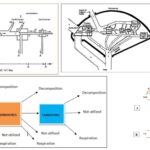What is a mitochondria
What is a mitochondria
Please login to submit an answer.
Mitochondria are double-membrane-bound organelles found in the cytoplasm of almost all eukaryotic cells, functioning as the primary site of aerobic respiration and ATP (adenosine triphosphate) production, which is the main energy currency of the cell.
Structurally, mitochondria consist of an outer membrane, an intermembrane space, an inner membrane, and a matrix.
The outer membrane is smooth and permeable to small molecules and ions.
The inner membrane is highly folded into structures called cristae, increasing surface area for biochemical reactions.
The matrix contains enzymes of the Krebs cycle, mitochondrial DNA (mtDNA), ribosomes, and other essential biomolecules.
Mitochondria are often termed the “powerhouse of the cell” because they convert the chemical energy stored in macronutrients (carbohydrates, fats, and proteins) into usable cellular energy in the form of ATP via oxidative phosphorylation.
These organelles possess their own circular DNA (mtDNA) and 70S ribosomes, supporting the endosymbiotic theory, which proposes that mitochondria originated from free-living prokaryotes engulfed by ancestral eukaryotic cells over 1.5 billion years ago.
Mitochondria perform multiple essential functions besides energy production:
Regulation of cellular metabolism
Apoptosis (programmed cell death) control
Calcium ion (Ca²⁺) storage and signaling
Synthesis of certain amino acids and heme groups
Reactive oxygen species (ROS) generation and detoxification
Mitochondrial number and structure can vary significantly between cell types depending on their energy demands. For example, muscle, heart, liver, and nerve cells contain a higher number of mitochondria due to their elevated metabolic activity.
Defects in mitochondrial function are linked to a range of metabolic, neurodegenerative, and age-related diseases, including mitochondrial myopathies, Parkinson’s disease, Alzheimer’s disease, and diabetes mellitus.
- Share on Facebook
- Share on Twitter
- Share on LinkedIn
Helpful: 0%




